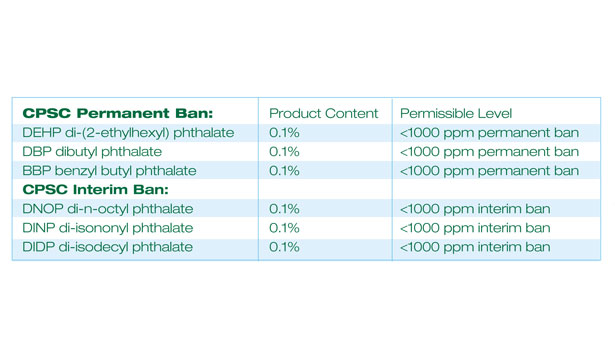You have, no doubt, seen this warning on consumer products.
Unsettling, without a doubt…
You may think, “That label says California. I live in Georgia, so I am safe, right?”
It is easy to be flippant, but the reality is troubling. No matter how much we want to disregard the dramatic reaction of California to these chemicals, we must wonder, “What if they are right?”
The “new car smell” is coming from Phthalate Plasticizers used in many parts of new cars. If you purchased a car in California, you have probably seen this warning label on the dash. Just don’t inhale while you drive that new car.
Plasticizers in products
Plasticizers, mainly of the Phthalate type, are added to PVC to make soft pliable products used in many different items including (but not limited to):
? Children’s toys
? Childcare items such as teethers and rattles
? Adhesives & sealants
? Lacquers, paints & inks
? Ceramics
? Car underbody spray coatings and Interior Synthetic Leather components
? Building materials
? Home furnishings
? Clothing (rainwear &boots)
? Gloves
? Medical devices
Obviously from the list of products above, Phthalate Plasticizers are quite ubiquitous due to the amount of production. Plus, this is only a partial list of products.
Because toxicity studies have shown either carcinomas or reproductive effects in laboratory animals, a number of plasticizers have been added to both the Proposition 65 list of chemicals and the European REACH list of Substances of Very High Concern.
Proposition 65
The warning label stems from the 1986 law named Proposition 65, voted into law because the people of California were concerned about exposure to unsafe chemicals. The law requires the state of California to publish a list of chemicals known to cause cancer or birth defects or other reproductive harm.
Companies doing business in the state of California must inform Californians about significant amounts of the chemicals on this list with a warning label. This warning label allows the citizen to make an informed decision about whether they believe purchasing a product is a threat to their health or to the environment.
Updated once per year, the Prop 65 list has grown to include more than 800 chemicals. Under Proposition 65 law, the Carcinogen Identification Committee and the Developmental & Reproductive Toxicant Committee review the latest toxicology research data and decide what chemicals are added to Prop 65. Chemicals are also added if an organization such as the EPA, the FDA, NIOSH, the National Toxicology Program or the International Agency for Research on Cancer has determined a chemical should be banned.
Once a chemical is listed on Prop 65, companies have 12 months to:
1. Prove the level of the chemical is below the “no effect” level.
2. Completely remove the chemical from the products they sell and change formulations.
3. Post a warning label on the product.
4. Stop selling the product in California.
Posting the warning label on a product shows commendable product stewardship but is risky to marketability. But not knowing or not labeling is not the answer.
Proposition 65 sets the safe level for a chemical by determining the “no observable effect level” and dividing this level by 1000.
REACH
Many aspects of Proposition 65 parallel the European REACH regulation. REACH stands for Registration, Evaluation, Authorization and restriction of Chemicals. REACH requires companies that sell in the 28 states of the European Union to report the amounts of chemicals in products identified as Substances of Very High Concern (SVHC) due to their toxicity.
The acute toxicity of Phthalate Plasticizers is low. That is, they would not be poisonous if eaten. The good news is that most Phthalates are readily metabolized and excreted and show no evidence of bioaccumulation in ecosystems.
Some Phthalates have been listed as carcinogenic because liver tumors have occurred in toxicity studies of rodents. Current research into tumor formation has caused doubt as to whether the same mechanism exists in humans.
Endocrine disruptors: Phthalates are described as endocrine disruptors. Research indicates endocrine disruptors are chemicals that may interfere with the body’s endocrine system and produce adverse developmental, reproductive, neurological, and immune effects in both humans and wildlife.
U.S. Consumer Product Safety Commission legislation
The Consumer Product Safety Improvement Act of 2008 imposed a permanent ban on three of the Phthalate Plasticizers and an interim ban on three others in children’s toys that can be placed in the mouth.
Is DEHP still out there?
Testing of more than 200 consumer products using GCMS Analysis found levels well above the Consumer Product Safety Commission (CPSC) limits in numerous products sold in the U.S. market. Only one product tested carried the Proposition 65 warning label. Some had no DEHP, while others had 75 to 750 times the allowed level of DEHP. This is 750 times higher than what CPSC considers safe. Most manufacturers are obviously unaware of this issue with their products or they would surely alter their formulations to eliminate this dangerous toxin.
Now DINP?
Here is a paradox. In Europe, DINP is considered a safe alternative to DEHP. DINP is considered a chemical of no concern.
DINP was added to the Proposition 65 list in December of 2013.
Indeed, DINP has been shown in several animal species to cause hepatocellular carcinomas. But the European Commission does not believe the mechanism of liver tumor generation occurs in humans. So DINP is not on the REACH list. DINP is neither recognized as carcinogenic by the International Agency for Research on Cancer. Many questions about listing this chemical on Proposition 65 and much opposition by manufacturers of this listing will likely occur for quite a while.
Are there any safe alternatives?
Safer plasticizers, available from major chemical companies worldwide, include:
- Adipates
- Citrates
- Cyclocarboxylic Acid Esters
- Terephthalates
- Benzoates
- Succinates
- Sebacates
- DINCH which is Di-(isononyl)-cyclohexane-1,2 dicarboxylate
? DOIP which is Dioctyl Isophthalate or Benzenecarboxylic acid bis-(ethylhexyl) ester
Many alternates are already used in products around the world. Some manufacturers and raw material suppliers that stopped using the lower phthalates such as DEHP, BBP, and DIBP switched to DINP. The paradox of being declared safe in Europe, but requiring a warning label in California, will be of major concern in the safety profession.
Consumers concerned about any item should obtain a declaration of content from the manufacturer providing evidence of safe levels of Phthalate plasticizers.
Manufacturers and importers who sell products must insist on declarations of proof from every vendor to ensure the safety of consumers and must label products accordingly.
Although the risks have been identified and laws have been written to limit human exposure to these chemicals, evidence shows that they are still out there.
Lawsuits
Numerous lawsuits have resulted from the Proposition 65. In 2012, settlements for Proposition 65 totaled more $22 million:
- civil penalties of more than $4 million (18.5%)
- attorneys’ fees of more than $15 million (69.3%)
- Other expenses (12.2%)
Numerous companies that sell into the retail market have been hit hard with these lawsuits, and anyone who sells industrially is likely to be sued. To avoid lawsuits, some companies have decided to put the warning label on their products regardless of the content.
Government intervention
In 2013, the government of California began looking into limiting the penalties for Proposition 65 because of excessive legal fees. The reform bill would limit attorneys’ fees in Proposition 65 cases. The reform would require more information for the public on what they are being exposed to and how to protect themselves.
Safe chemical levels
Every company that practices good product stewardship and proper concern over public health must take action to provide products that are safe for consumers and the environment and that do not contain hidden hazards.


